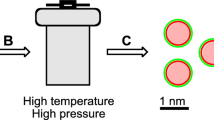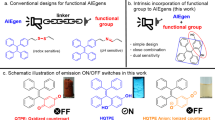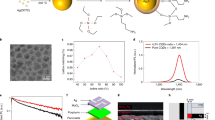Abstract
Semiconductor quantum dots (QDs) have been widely used for fluorescent labelling. However, their ability to transfer electrons and holes to biomolecules leads to spectral changes and effects on living systems that have yet to be exploited. Here we report the first cell-based biosensor based on electron transfer between a small molecule (the neurotransmitter dopamine) and CdSe/ZnS QDs. QD–dopamine conjugates label living cells in a redox-sensitive pattern: under reducing conditions, fluorescence is only seen in the cell periphery and lysosomes. As the cell becomes more oxidizing, QD labelling appears in the perinuclear region, including in or on mitochondria. With the most-oxidizing cellular conditions, QD labelling throughout the cell is seen. Phototoxicity results from the creation of singlet oxygen, and can be reduced with antioxidants. This work suggests methods for the creation of phototoxic drugs and for redox-specific fluorescent labelling that are generalizable to any QD conjugated to an electron donor.
This is a preview of subscription content, access via your institution
Access options
Subscribe to this journal
Receive 12 print issues and online access
$259.00 per year
only $21.58 per issue
Buy this article
- Purchase on Springer Link
- Instant access to full article PDF
Prices may be subject to local taxes which are calculated during checkout






Similar content being viewed by others
References
Anderson, N. A. & Lian, T. Ultrafast electron transfer at the molecule-semiconductor nanoparticle interface. Annu. Rev. Phys. Chem. 56, 491–519 (2005).
Dimitrijevic, N. M., Saponjic, Z. V., Rabatic, B. M. & Rajh, T. Assembly and charge transfer in hybrid TiO(2) architectures using biotin-avidin as a connector. J. Am. Chem. Soc. 127, 1344–1345 (2005).
Ginger, D. S. & Greenham, N. C. Photoinduced electron transfer from conjugated polymers to CdSe nanocrystals. Phys. Rev. B 59, 10622–10629 (1999).
Nozik, A. J. Quantum dot solar cells. Physica E 14, 115–120 (2002).
Landes, C., Burda, C., Braun, M. & El-Sayed, M. A. Photoluminescence of CdSe nanoparticles in the presence of a hole acceptor: n-butylamine. J. Phys. Chem. B 105, 2981–2986 (2001).
Kloepfer, J. A., Bradforth, S. & Nadeau, J. L. Photo-physical properties of biologically compatible CdSe quantum dot structures. J. Phys. Chem. B 109, 9996–10003 (2005).
Lakowicz, J. R. Principles of Fluorescence Spectroscopy (Plenum, New York, 1999).
Aldana, J., Lavelle, N., Wang, Y. J. & Peng, X. G. Size-dependent dissociation pH of thiolate ligands from cadmium chalcogenide nanocrystals. J. Am. Chem. Soc. 127, 2496–2504 (2005).
Rajh, T. et al. Surface restructuring of nanoparticles: An efficient route for ligand-metal oxide crosstalk. J. Phys. Chem. B 106, 10543–10552 (2002).
Jeong, S. et al. Effect of the thiol-thiolate equilibrium on the photophysical properties of aqueous CdSe/ZnS nanocrystal quantum dots. J. Am. Chem. Soc. 127, 10126–10127 (2005).
Floresca, C. Z. & Schetz, J. A. Dopamine receptor microdomains involved in molecular recognition and the regulation of drug affinity and function. J. Recept. Signal. Transduct. Res. 24, 207–239 (2004).
Javitch, J. A., Li, X., Kaback, J. & Karlin, A. A cysteine residue in the third membrane-spanning segment of the human D2 dopamine receptor is exposed in the binding-site crevice. Proc. Natl Acad. Sci. USA 91, 10355–10359 (1994).
Pinaud, F., King, D., Moore, H. P. & Weiss, S. Bioactivation and cell targeting of semiconductor CdSe/ZnS nanocrystals with phytochelatin-related peptides. J. Am. Chem. Soc. 126, 6115–6123 (2004).
Lovric, J. et al. Differences in subcellular distribution and toxicity of green and red emitting CdTe quantum dots. J. Mol. Med. 83, 377–385 (2005).
Parak, W. J., Pellegrino, T. & Plank, C. Labelling of cells with quantum dots. Nanotechnology 16, R9–R25 (2005).
Ipe, B. I., Lehnig, M. & Niemeyer, C. M. On the generation of free radical species from quantum dots. Small 1, 706–709 (2005).
Samia, A. C. S., Chen, X. B. & Burda, C. Semiconductor quantum dots for photodynamic therapy. J. Am. Chem. Soc. 125, 15736–15737 (2003).
Bakalova, R. et al. Quantum dot anti-CD conjugates: Are they potential photosensitizers or potentiators of classical photosensitizing agents in photodynamic therapy of cancer? Nano Lett. 4, 1567–1573 (2004).
Lichszteld, K., Michalska, T. & Kruk, I. Identification by Esr spectroscopy and spectrophotometry of singlet oxygen, formed during autoxidation of catecholamines. Z. Phys. Chem. 175, 117–122 (1992).
Limaye, D. A. & Shaikh, Z. A. Cytotoxicity of cadmium and characteristics of its transport in cardiomyocytes. Toxicol. Appl. Pharmacol. 154, 59–66 (1999).
Derfus, A. M., Chan, W. C. W. & Bhatia, S. N. Probing the cytotoxicity of semiconductor quantum dots. Nano Lett. 4, 11–18 (2004).
Kirchner, C. et al. Cytotoxicity of colloidal CdSe and CdSe/ZnS nanoparticles. Nano Lett. 5, 331–338 (2005).
Chen, C. S. & Gee, K. R. Redox-dependent trafficking of 2,3,4,5,6-pentafluorodihydrotetramethylrosamine, a novel fluorogenic indicator of cellular oxidative activity. Free Radic. Biol. Med. 28, 1266–1278 (2000).
Anderson, M. E. Glutathione: an overview of biosynthesis and modulation. Chem. Biol. Interact. 111–112, 1–14 (1998).
Kloepfer, J. A., Mielke, R. E. & Nadeau, J. L. Uptake of CdSe and CdSe/ZnS quantum dots into bacteria via purine-dependent mechanisms. Appl. Environ. Microbiol. 71, 2548–2557 (2005).
Kloepfer, J. A. et al. Quantum dots as strain- and metabolism-specific microbiological labels. Appl. Environ. Microbiol. 69, 4205–4213 (2003).
Chen, Y. F., Ji, T. H. & Rosenzweig, Z. Synthesis of glyconanospheres containing luminescent CdSe-ZnS quantum dots. Nano Lett. 3, 581–584 (2003).
Press, W. H., Flannery, B. P., Teukolsky, S. A. & Vetterling, W. T. Numerical Recipes in Fortran (Cambridge Univ. Press, New York, 1992).
Aldana, J., Wang, Y. A. & Peng, X. G. Photochemical instability of CdSe nanocrystals coated by hydrophilic thiols. J. Am. Chem. Soc. 123, 8844–8850 (2001).
Acknowledgements
This research is supported by the United States EPA—Science to Achieve Results (STAR) program Grant No. R831712, and by the Canadian Institutes of Health Research (CIHR) Grant No. PPP-71486. S.J.C. acknowledges support from The Banting Research Foundation. N.M.D. is supported by the Office of Basic Energy Sciences, Division of Chemical Sciences, US-DOE under contract number W-31-109-Eng-38. The TCSPC work carried out at USC is supported by the David and Lucile Packard Foundation and NASA-JPL instrument contract 1 250 277.
Author information
Authors and Affiliations
Corresponding author
Ethics declarations
Competing interests
The authors declare no competing financial interests.
Supplementary information
Supplementary Information
Supplementary figures S1 - S4, supplementary table 1 and supplementary methods (PDF 3672 kb)
Supplementary Information
Supplementary video S1 (MOV 45 kb)
Supplementary Information
Supplementary video S2 (MOV 43 kb)
Rights and permissions
About this article
Cite this article
Clarke, S., Hollmann, C., Zhang, Z. et al. Photophysics of dopamine-modified quantum dots and effects on biological systems. Nature Mater 5, 409–417 (2006). https://doi.org/10.1038/nmat1631
Received:
Accepted:
Published:
Issue Date:
DOI: https://doi.org/10.1038/nmat1631
This article is cited by
-
Emerging application of nanotechnology for mankind
Emergent Materials (2023)
-
Quantum Dots Compete at the Acme of MXene Family for the Optimal Catalysis
Nano-Micro Letters (2022)
-
Colloidal stability and aggregation kinetics of nanocrystal CdSe/ZnS quantum dots in aqueous systems: effects of pH and organic ligands
Journal of Nanoparticle Research (2020)
-
Melanin/polydopamine-based nanomaterials for biomedical applications
Science China Chemistry (2019)
-
Ratiometric determination of hydrogen peroxide based on the size-dependent green and red fluorescence of CdTe quantum dots capped with 3-mercaptopropionic acid
Microchimica Acta (2019)



